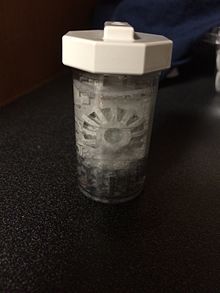Hydrogen peroxide contact solutions: Difference between revisions
Added {{copy edit}} and {{essay-like}} tags to article (TW) |
m Template might not be the nicest way to put it. |
||
| Line 1: | Line 1: | ||
{{copy edit|date=February 2016}} |
{{copy edit|date=February 2016}} |
||
{{essay-like|date=February 2016}} |
|||
[[File:Hydrogen peroxide contact case.jpg|thumb|Case used for hydrogen peroxide contact solution.]] |
[[File:Hydrogen peroxide contact case.jpg|thumb|Case used for hydrogen peroxide contact solution.]] |
||
'''Hydrogen peroxide contact solutions''' are storage solutions for [[contact lens]] that rely on [[hydrogen peroxide]] to clean the contacts and break up proteins and deposits during the disinfection process. |
'''Hydrogen peroxide contact solutions''' are storage solutions for [[contact lens]] that rely on [[hydrogen peroxide]] to clean the contacts and break up proteins and deposits during the disinfection process. |
||
Revision as of 00:13, 19 February 2016
This article may require copy editing for grammar, style, cohesion, tone, or spelling. (February 2016) |

Hydrogen peroxide contact solutions are storage solutions for contact lens that rely on hydrogen peroxide to clean the contacts and break up proteins and deposits during the disinfection process.
How It Works
The majority of hydrogen peroxide solutions are three percent hydrogen peroxide.[1] This enables the solution to break down the proteins that have coated the contacts after a long period of use. However, hydrogen peroxide is not designed to come into contact with your eye. If it does directly touch the eye, it can damage the corneal cells in the epithelium. While this won't result in any permanent damage, it can cause a very intense burn that can linger even after the solution has been rinsed from the eye. The cells will heal very quickly once the natural tear film is restored.[2] In order to prevent this damage to the eye, the solution must be stabilized before the contacts are placed into the individual's eyes. To stabilize the solution, the contacts are placed into a special container that has platinum coated disk. When this disk is placed into the solution, it not only gets rid of the hydrogen peroxide, but it also produces small bubbles that help to clean the contacts. After a couple of hours, the hydrogen peroxide will be stabilized and what is left is a saline solution.[3] At this point, it is safe to use the contacts. It is important to note that after an extended period of use, the platinum coated disk will no longer be effective and will need to be replaced.
Hydrogen Peroxide versus multipurpose solutions
Both hydrogen peroxide and multipurpose solutions function to remove debris and build-up from contact lenses. However, there are a few significant differences between the two. Hydrogen peroxide has the ability to penetrate microbial films, which helps create a deeper clean. Hydrogen peroxide solutions also do not contain preservatives.[4] This can be very beneficial for people who are allergic or sensitive to the preservatives in multipurpose solutions. Hydrogen peroxide solutions also have a greater ability to fight acanthamoeba keratitis, which is an infection that can cause blindness. Multipurpose solutions, on the other hand, have their advantages as well. For one, they tend to be more inexpensive than hydrogen peroxide solutions.[5] Also, contacts do not have to be placed in multipurpose solutions for a certain period of time, whereas contacts must be left in a hydrogen peroxide solution for a few hours in order for the solution to be stabilized. The main attraction of multipurpose solutions is that a person can use the same solution to clean, rinse, disinfect, and store contact lens.[6] You would need a separate solution in order to rinse the contacts if you are using the hydrogen peroxide solution. When using peroxide solutions, one also runs the risk of making a mistake in the neutralization process. This could result in accidentally having the hydrogen peroxide come into contact with the eye.
Types of Hydrogen Peroxide Solutions
Generally, most hydrogen peroxide solutions cost around ten to twenty dollars. Currently, there are three main name brands of this type of solution along with several generic brands. The three brands are Clear Care, Oxysept, and AOspet. The most popular is Clear Care. Clear Care makes up more than 80 percent of the peroxide systems sold in the U.S.[7] The thing that separates Clear Care from the other two is that it contains a surfactant that helps loosen debris and deposits.[8] Clear Care also has a platinum disk that neutralizes the solution and is good for up to 100 uses. AOsept is another peroxide solution that uses a disk to neutralize the solution. The disk used to have to be purchased separately, but now it is included in the kit. This brand is scheduled to be phased out by the end of this year. Oxysept is slightly different from the other two brands in the fact that it uses tablets in the neutralization, which causes a slower process. The result of the tablets is a longer exposure to more concentrated hydrogen peroxide. Some say this is beneficial. It is also suggested that an enzymatic cleaner be added weekly, which might make this solution more expensive.[9]
References
- ^ "Which Contact Solution Is the Best?". Allaboutvision.com. Retrieved 2015-09-01.
- ^ Brimer, Crystal. "H202…What's behind the bubbles?". ModernMedicine Network. Retrieved August 31, 2015.
- ^ "CIBA Vision Clear Care: a hydrogen peroxide based cleaner for contact lenses". Using Hydrogen Peroxide. Retrieved August 30, 2015.
- ^ "A Guide To Cleaning Your Contact Lenses With Hydrogen Peroxide". EyeHealthWeb. Retrieved August 30, 2015.
- ^ Heiting, Gary. "Which Contact Solution Is the Best?". All About Vision. Retrieved August 30, 2015.
- ^ "Your Guide to Contact Lens Solution". 1 800 Contacts. Retrieved August 30, 2015.
- ^ Brimer, Crystal. "H202…What's behind the bubbles?". ModernMedicine Network. Retrieved August 30, 2015.
- ^ "Difference Between AOsept and Clear Care". DifferenceBetween.net. Retrieved August 30, 2015.
{{cite web}}:|first1=missing|last1=(help) - ^ Brimer, Crystal. "H202…What's behind the bubbles?". ModernMedicine Network. Retrieved August 30, 2015.
